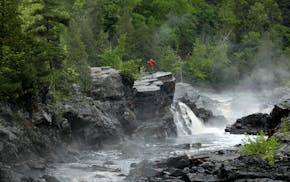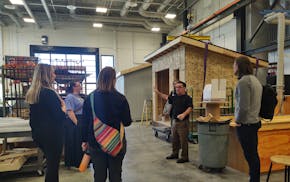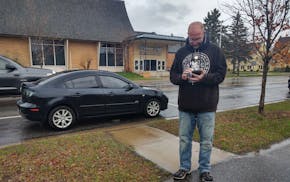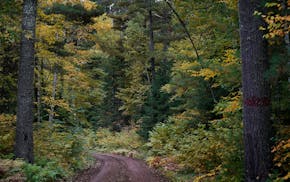Ozzie Reif's hike into the Boundary Waters Canoe Area Wilderness in August wasn't your typical wilderness trek. It was an art project.
And in an era of microplastics, PFAS contamination and fast fashion, it was a demonstration that you can go into one of the toughest environments in Minnesota without first stocking up on commercial wilderness supplies.
It started when Reif, 27, applied for an artist grant through the Arrowhead Regional Arts Council. It wasn't the usual artist grant for things like gallery displays or poetry workshops. His idea was to make his own gear out of natural materials for a 110-mile trip into the Boundary Waters.
Reif is well-versed in the ways of the wilderness area, having first set foot there when he was 16. During college in Oregon, he spent summers in Ely, Minn., working as a guide. He moved there full time when he graduated. Reif has made too many trips into the wilderness to count.
But as time passed, he became more aware of the many ways humans affect the land — especially how microplastics are thought to contaminate pristine places like Antarctica partly through shedding from synthetic clothing, like fleece, and how researchers have discovered chemicals from sunscreen and insect repellant in underwater life.
"I've always thought about that, and I generally try to minimize my consumption of buying clothes and buying new gear," he said. "I have a rain jacket that leaks a little bit, and I've had it for a decade and it's fine."
He's got plenty of company. Around the globe, outdoors enthusiasts are holding outdoor clothing and gear companies to higher standards, demanding accountability and transparency in their environmental impact and how they source their materials.
Reif got the grant and in May began preparing for his trip. He pounded on a downed ash tree to make strips to weave into a basket with leather straps. He ordered a copper sheet to hammer into a pot. He waxed the inside of a gourd he'd had for years for use as a drinking vessel. From friend Mark Olson of Ely, he got deer and moose leather to make two pairs of moccasins.
He made his own ropes from wool, climbing a fire tower in order to make the 40-foot bear bag rope. For a sleeping bag, he stitched together a wool blanket that fit inside a sheet of waxed canvas with drawstrings for tightening. He carried a waxed tarp that kept his things dry when it rained. He made his own clothes, including his underwear.
Reif tried to work with local companies as much as possible, including the native-owned Heart Berry in Cloquet, and he wanted to credit his basket weaving and moccasin making skills to Indigenous knowledge.
His trip wasn't a complete rejection of modern materials. Some of the thread he used contained polyester, and his food remained in its original plastic. He also carried a first aid kit with modern bandages and gauze.
"That was definitely one of the angles of this project," he said. "I don't know if it's making a statement or just personally trying to remove myself from that manufacturing stream as much as possible."
Reif began hiking on Aug. 20, came out on Aug. 23 to make a presentation at the Chik-Wauk Museum and Nature Center in Grand Marais, slept two nights at the Gunflint Lodge bunkhouse, resumed his hike and finished on Friday. He covered about 70 miles, short of his goal, but the trail was so challenging that at some point, he was traveling only about a mile an hour.
Plus, his legs hurt.
He figured it was from the moccasins. Modern footwear often comes with ankle support, and his body wasn't used to traversing such rough terrain without it. He could feel everything through the thin soles.
Probably a bigger reason to cut his trip short was that he discovered he had not properly waxed the inside of the drinking gourd. Chunks of wax began falling out as he drank, and the gourd developed a funky taste and smell.
You might be wondering what Reif did for drinking water. I'm going to tell you, though he strongly advises people not to do what he did, and he's still waiting to see if he develops symptoms of giardia. Without filters, he filled the gourd with straight lake water. He went out a ways from shore, avoided beaver dams and sank the gourd several inches below the surface.
Now that's commitment to the cause. Although if you think about it, the voyageurs probably didn't take the time to boil water every time they needed a drink.
Reif is not alone in his quest to live lightly on the land. Olson, the friend who supplied him with moose and deer hide, tans his own hides and turns them into shirts and mukluks. Properly prepared, the leather will last for years, with the exception of shoe soles, Olson said.
Reif and Olson teach classes through local folk schools. Most of us lack their skills. But they're there to inspire, not to judge. If you need to bring filters, sleeping bags and plastic water jugs to have a great wilderness trip, bring 'em, Reif says.
"Your first trip, you have to have it be very nice and fun, super dry and super warm, or you're not going to come back," he said. "The more comfortable you become, the more experiences you have, the more you're able to analyze your impact on it."
Karen Tolkkinen is a columnist for the Star Tribune, focused on the issues and people of greater Minnesota. Reach her at karen.tolkkinen@startribune.com or 612-673-4007.

Tolkkinen: Fergus Falls priest who studied with Pope Leo says he has good hearing 'to hear everyone'

Tolkkinen: Just when I was starting to lose myself in nature's grandeur, along came a motorcycle

Tolkkinen: On a three-day northern Minnesota tour, the grit and glory of our state became clear

Tolkkinen: Brainerd City Council should spend a night, or 30, sleeping outdoors


